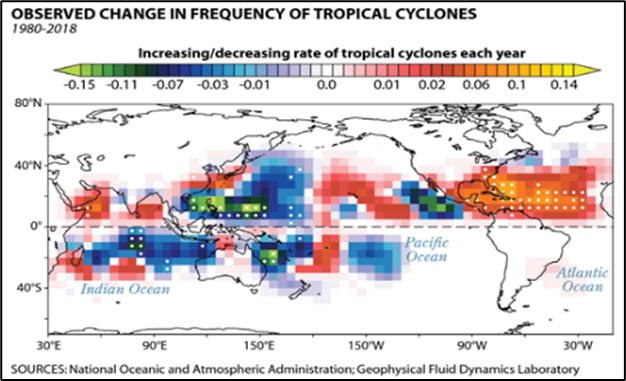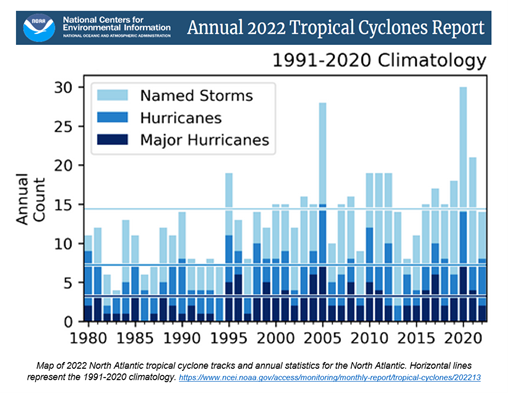Archived Content
In an effort to keep CISA.gov current, the archive contains outdated information that may not reflect current policy or programs.Tropical Cyclones


When tropical cyclones encounter land, their intense rains and high winds can cause severe property damage, loss of life, soil erosion, and flooding. The associated storm surge—the large volume of ocean water pushed toward shore by the cyclone’s strong winds—can cause severe flooding, additional erosion, and extensive destruction.
- Once a tropical cyclone reaches maximum sustained winds of 74 miles per hour or higher, it is then classified as a hurricane, typhoon, or tropical cyclone, depending upon where the storm originates in the world.
- In the North Atlantic, central North Pacific, and eastern North Pacific, the term hurricane is used.
Warmer oceans produce more evaporation, which means more water is available in the atmosphere as water vapor and allows for more rain. This increased rain releases more heat and amplifies winds around the core of the cyclone. These climate amplified tropical cyclones have caused over $1,333 billion in damages since 1980.
- A study analyzing the 2020 North Atlantic hurricane season found that hourly hurricane rainfall totals were around 10% higher compared to hurricanes recorded in the pre-industrial (1850s) era.
- A recent study from Yale using data from 2020’s cyclone Alpha and 2021’s cyclone Henri states the next 75 years will see an expansion of hurricanes/typhoons into mid-latitude regions, including major cities such as New York, Boston, Beijing, and Tokyo.
- A recent assessment indicated an increase of global tropical cyclone rainfall rates at 7% per degree of Celsius of warming with an observational finding of a 1.3% global increase in tropical cyclone rainfall rates per year since the early 1900s.
NOAA recently released a new explanatory guide: this information could be a useful guide to distribute to staff, as it succinctly covers the dangers of hurricanes and how to plan for them. 57% of fatalities during tropical cyclones have been caused by storm surge.
- Storm inundation levels during hurricane surge events will increase due to sea level rise, anticipated to rise by about 2 to 3 ft by 2100.
- The strongest winds of tropical storms and hurricanes are projected to increase about 3%.
- Due to extreme weather, precipitation rates within tropical storms and hurricanes are projected to increase by about 15% and the number of Atlantic hurricanes reaching Category 4 or 5 intensity are projected to increase about 10%.
An assessment by hurricane experts correlates an increase in intensity and the proportion of the most intense storms. In addition, the occurrence of storms resulting in extreme rainfall rates over 3-hour timeframes increased by 10%, while 3-day total rainfall accumulations increased by 5% for tropical storm and hurricane strength systems.
- Extreme rainfall rates when focusing on hurricane strength only saw increases for 3-hourly rainfall rates of 11% and 3-day total accumulated rainfall by 8%. Damaging winds associated with tropical low centers are also expected to increase.
Tropical cyclones produce torrential flooding, damaging winds, tornadic activity, erosion, hail, storm surge, and coastal flooding within their storm path which can span numerous states and cause severe damage to critical infrastructure.
CISA’s Role in Increasing Tropical Cyclone Resiliency
CISA provides a regional Protective Security Advisor (PSA) to staff the State Emergency Operations Center (EOC) during activations and assists with infrastructure of concern (IOC) lists to include public utilities, hospitals, seaports, or chemical facilities, and more. CISA’s PSAs work with partners to facilitate energy and telecommunication restoration efforts as well.
CISA produces annual webinars ahead of hurricane season to inform stakeholders and communities how the agency facilitates the National Coordinating Center for Communications (ESF#2), Cross Sector Business and Infrastructure (ESF#14), National Business Emergency Operations Center (NBEOC), and the National Risk Management Center (NRMC) coordinating with National Oceanic and Atmospheric Administration (NOAA) to plan response efforts efficiently.
CISA also urges all users to remain on alert for malicious cyber activity following natural disasters, such as hurricanes, as attackers target disaster victims and concerned citizens by leveraging social engineering tactics, techniques, and procedures (TTPs).
Critical Infrastructure Impacts
- Tropical cyclones produce torrential flooding, damaging winds, tornadic activity, erosion, hail, storm surge, and coastal flooding within their storm path which can span numerous states and cause severe damage to critical infrastructure systems. Most damage is caused by copious amounts of water and/or high winds brought about by the tropical storms.
- Flooding damages to energy infrastructure are considerably higher from tropical weather as a combination of overflowing rivers, storm surge, and torrential rains can compound to result in standing water able to reach 1-story deep. Flooding can cause prolonged power outages which can stop elevators, hinder remote entry points, impede refrigeration, disrupt emergency services sites, and damage security features state facilities need to operate.
- Sudden heavy floodwaters can severely degrade earthen and lined irrigation canals through increased rates of subsidence, erosion, or sediment flows. Flash flooding may carry high levels of raw sewage and debris into waterways and local wells, overwhelming intakes for water treatment facilities and impacting local and regional drinking supplies.
- Storm surge and coastal inundation of roadways, pipelines, runways, and railways can result in erosion of material, reduced load bearing capacity of material, sinkholes, and debris flows. Sinkholes can form from water weight damaging the structural integrity of sewer systems or from compromised soil composition such as eroded surface rock.
- Tropical cyclone winds can damage site integrity and equipment in a wider swath than most tornado events. Continuous winds from thunderstorms in the rainbands and associated with the eyewall can cause tornadic strength gusts to persist for hours to days. Most powerlines can withstand winds around 55mph, while severe storms in rainbands can produce sustained winds over 75 mph and gusts near 160 mph.
- Power outages and physical damage caused by severe weather can impact all aspects of communication, transportation, emergency services, and water systems. As the cyclones move inland, impacts from the storm often continue to pose a significant threat to infrastructure across multiple regions.
- In 2017, Hurricanes Irma and Maria wreaked havoc in Puerto Rico and damaged the electricity grid so severely, it caused the longest blackout in U.S. history (11 months).
- From 1980–2023, there have been 62 tropical cyclones that caused more than $1 billion in losses.
- Tropical cyclones can destroy or severely damage coastal infrastructure. Between 2020 and 2021, Louisiana was hit by Hurricanes Laura, Delta, Zeta, and Ida, which collectively caused more than $579 million in losses to the state’s fisheries infrastructure, revenue, and biological resources.
Tropical Cyclones Resources and Training
These resources provide insight on how extreme weather is affecting tropical cyclones and the impacts these strengthening storms may have on critical infrastructure systems.
Fifth National Climate Assessment: Extreme Events Are Becoming More Frequent and Severe
The Fifth National Climate Assessment discusses how the risk of extreme temperatures has changed in approximately the past 100 years.
Hurricanes | Ready.gov
Learn how to stay safe before, during, and after a hurricane.
NASA - A Force of Nature: Hurricanes in a Changing Climate
Due to global warming, global climate models predict hurricanes will likely cause more intense rainfall and have an increased coastal flood risk due to higher storm surge caused by rising seas.
NOAA Geophysical Fluid Dynamics Laboratory: Extreme Weather and Hurricanes
Review current research on the link between global warming and hurricanes.
HURREVAC – Hurricane Decision Support
HURREVAC is the decision support tool of the National Hurricane Program, administered by FEMA, the USACE, and the NOAA National Hurricane Center.
Best Practices for Identifying and Communicating Tropical Cyclone Threats and Impacts
Take on the role of a forecaster, converse with a local emergency manager about storm threats and impacts and use national products to communicate risk.




